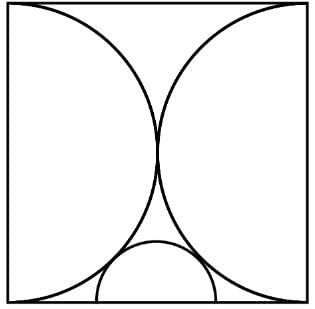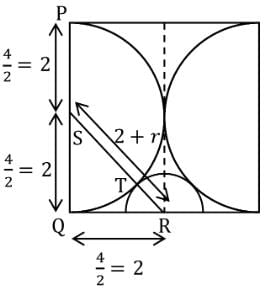GRE Exam > GRE Questions > In the square shown below, the side is 4 unit...
Start Learning for Free
In the square shown below, the side is 4 units. The three semicircles with their diameters along the sides of the square touch each other as shown. What is the diameter of the smaller semicircle?


- a)√2 − 1
- b)2√2 − 2
- c)√2
- d)4√2 − 4
- e)√3
Correct answer is option 'D'. Can you explain this answer?
Verified Answer
In the square shown below, the side is 4 units. The three semicircles ...

In the above diagram, S and R are the centers of the semicircles.
PS = SQ = QR = Half the side of the square = 2
Thus: ST = Radius of the bigger semicircle = 2
Let the radius of the smaller semicircle = r
⇒ SR = 2 + r
Thus, from Pythagoras' theorem in triangle SQR:
⇒ SR = 2 + r
Thus, from Pythagoras' theorem in triangle SQR:
SR2 = SQ2 + QR2
⇒ (2 + r)2 = 22 + 22 = 8
Taking square-root throughout:
⇒ (2 + r)2 = 22 + 22 = 8
Taking square-root throughout:
⇒ 2 + r = √8 = 2√2
⇒ r = 2√2 − 2
⇒ Diameter = 4√2 − 4
The correct answer is option D.
⇒ r = 2√2 − 2
⇒ Diameter = 4√2 − 4
The correct answer is option D.
Most Upvoted Answer
In the square shown below, the side is 4 units. The three semicircles ...

In the above diagram, S and R are the centers of the semicircles.
PS = SQ = QR = Half the side of the square = 2
Thus: ST = Radius of the bigger semicircle = 2
Let the radius of the smaller semicircle = r
⇒ SR = 2 + r
Thus, from Pythagoras' theorem in triangle SQR:
⇒ SR = 2 + r
Thus, from Pythagoras' theorem in triangle SQR:
SR2 = SQ2 + QR2
⇒ (2 + r)2 = 22 + 22 = 8
Taking square-root throughout:
⇒ (2 + r)2 = 22 + 22 = 8
Taking square-root throughout:
⇒ 2 + r = √8 = 2√2
⇒ r = 2√2 − 2
⇒ Diameter = 4√2 − 4
The correct answer is option D.
⇒ r = 2√2 − 2
⇒ Diameter = 4√2 − 4
The correct answer is option D.
Free Test
FREE
| Start Free Test |
Community Answer
In the square shown below, the side is 4 units. The three semicircles ...

In the above diagram, S and R are the centers of the semicircles.
PS = SQ = QR = Half the side of the square = 2
Thus: ST = Radius of the bigger semicircle = 2
Let the radius of the smaller semicircle = r
⇒ SR = 2 + r
Thus, from Pythagoras' theorem in triangle SQR:
⇒ SR = 2 + r
Thus, from Pythagoras' theorem in triangle SQR:
SR2 = SQ2 + QR2
⇒ (2 + r)2 = 22 + 22 = 8
Taking square-root throughout:
⇒ (2 + r)2 = 22 + 22 = 8
Taking square-root throughout:
⇒ 2 + r = √8 = 2√2
⇒ r = 2√2 − 2
⇒ Diameter = 4√2 − 4
The correct answer is option D.
⇒ r = 2√2 − 2
⇒ Diameter = 4√2 − 4
The correct answer is option D.

|
Explore Courses for GRE exam
|

|
Question Description
In the square shown below, the side is 4 units. The three semicircles with their diameters along the sides of the square touch each other as shown. What is the diameter of the smaller semicircle?a)√2 − 1b)2√2 − 2c)√2d)4√2 − 4e)√3Correct answer is option 'D'. Can you explain this answer? for GRE 2025 is part of GRE preparation. The Question and answers have been prepared according to the GRE exam syllabus. Information about In the square shown below, the side is 4 units. The three semicircles with their diameters along the sides of the square touch each other as shown. What is the diameter of the smaller semicircle?a)√2 − 1b)2√2 − 2c)√2d)4√2 − 4e)√3Correct answer is option 'D'. Can you explain this answer? covers all topics & solutions for GRE 2025 Exam. Find important definitions, questions, meanings, examples, exercises and tests below for In the square shown below, the side is 4 units. The three semicircles with their diameters along the sides of the square touch each other as shown. What is the diameter of the smaller semicircle?a)√2 − 1b)2√2 − 2c)√2d)4√2 − 4e)√3Correct answer is option 'D'. Can you explain this answer?.
In the square shown below, the side is 4 units. The three semicircles with their diameters along the sides of the square touch each other as shown. What is the diameter of the smaller semicircle?a)√2 − 1b)2√2 − 2c)√2d)4√2 − 4e)√3Correct answer is option 'D'. Can you explain this answer? for GRE 2025 is part of GRE preparation. The Question and answers have been prepared according to the GRE exam syllabus. Information about In the square shown below, the side is 4 units. The three semicircles with their diameters along the sides of the square touch each other as shown. What is the diameter of the smaller semicircle?a)√2 − 1b)2√2 − 2c)√2d)4√2 − 4e)√3Correct answer is option 'D'. Can you explain this answer? covers all topics & solutions for GRE 2025 Exam. Find important definitions, questions, meanings, examples, exercises and tests below for In the square shown below, the side is 4 units. The three semicircles with their diameters along the sides of the square touch each other as shown. What is the diameter of the smaller semicircle?a)√2 − 1b)2√2 − 2c)√2d)4√2 − 4e)√3Correct answer is option 'D'. Can you explain this answer?.
Solutions for In the square shown below, the side is 4 units. The three semicircles with their diameters along the sides of the square touch each other as shown. What is the diameter of the smaller semicircle?a)√2 − 1b)2√2 − 2c)√2d)4√2 − 4e)√3Correct answer is option 'D'. Can you explain this answer? in English & in Hindi are available as part of our courses for GRE.
Download more important topics, notes, lectures and mock test series for GRE Exam by signing up for free.
Here you can find the meaning of In the square shown below, the side is 4 units. The three semicircles with their diameters along the sides of the square touch each other as shown. What is the diameter of the smaller semicircle?a)√2 − 1b)2√2 − 2c)√2d)4√2 − 4e)√3Correct answer is option 'D'. Can you explain this answer? defined & explained in the simplest way possible. Besides giving the explanation of
In the square shown below, the side is 4 units. The three semicircles with their diameters along the sides of the square touch each other as shown. What is the diameter of the smaller semicircle?a)√2 − 1b)2√2 − 2c)√2d)4√2 − 4e)√3Correct answer is option 'D'. Can you explain this answer?, a detailed solution for In the square shown below, the side is 4 units. The three semicircles with their diameters along the sides of the square touch each other as shown. What is the diameter of the smaller semicircle?a)√2 − 1b)2√2 − 2c)√2d)4√2 − 4e)√3Correct answer is option 'D'. Can you explain this answer? has been provided alongside types of In the square shown below, the side is 4 units. The three semicircles with their diameters along the sides of the square touch each other as shown. What is the diameter of the smaller semicircle?a)√2 − 1b)2√2 − 2c)√2d)4√2 − 4e)√3Correct answer is option 'D'. Can you explain this answer? theory, EduRev gives you an
ample number of questions to practice In the square shown below, the side is 4 units. The three semicircles with their diameters along the sides of the square touch each other as shown. What is the diameter of the smaller semicircle?a)√2 − 1b)2√2 − 2c)√2d)4√2 − 4e)√3Correct answer is option 'D'. Can you explain this answer? tests, examples and also practice GRE tests.

|
Explore Courses for GRE exam
|

|
Signup for Free!
Signup to see your scores go up within 7 days! Learn & Practice with 1000+ FREE Notes, Videos & Tests.























